
Gallery Photographers
Partner
Artists-in-Residence
Image City Feature Articles
If you are unable to visit our gallery and would like to purchase photographs from this preview or others in the gallery, please contact the gallery and call 585-271-2540.
Gallery Picks of the Show
2 Men, 2 Visionsby Dick Bennett and Carl Crumley
Gallery Partners' have chosen their "Picks of the Show"
click here to return to the details of the exhibit
All images copyright by the individual photographers
Leopard Cub
Angel Fish
Michelle has presented an excellent series of
photographs taken on a recent trip to Antarctica. Noted photographer and
educator Jay Maisel teaches that
one component of a good photograph is something he calls “gesture”. For example, a picture of a small boy with his
hands at his side is far less engaging that one where he is doing
something, like waving or hands on hips, etc. Jay teaches that gesture
is not only something that can be shown by people, but it can be shown
by animals and inanimate objects as well Another component of a strong photograph is a
strong graphic composition for the viewer to admire.
This photograph presents all of these factors in a very creative
way. The sea lion is not
shown in complete form, only the head and one of its flippers is
presented. There is a whimsical feeling to the photograph, the
tendency to anthropomorphize animals is something that we all do and
this image allows the viewer to do this, attributing strong feelings
about the subject to the viewer. The use of minimal color is very effective,
reflecting the minimum pallet that is most likely presented to the
photographer. The blue
background, the amazing actual color of ice in Antarctica nicely frames
the body of the subject. This photo is NOT just a documentation of what a
sea lion looks like, but is ABOUT the sea lion.
The viewer feels a strong affinity to this animal, and the
enjoyment that it appears to being displaying.
Even lying on the frigid surface of the ice!
Partners' Picks
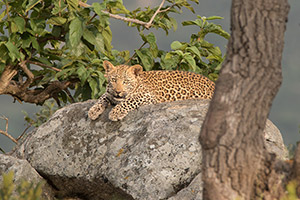
by Dick Bennett
Dick Bennett has produced this
captivating photograph of a beautiful leopard cub. For good reason he
needed to take this photograph from a significant distance from the cub
and by shooting through a variety of interfering subject matter. By
using selective focus he was able to isolate the cub and the gray rock
upon which he/she is perched as the only subject matter that is
distinctly in focus. The viewer’s attention, like in all photographs, is
attracted to the sharpest objects in the image. By virtue of its
sharpness the leopard cub perched upon the gray rock becomes the subject
of the photograph.
There are other reasons that our eyes and
minds are attracted to the cub. Stare for a moment at the two eyes of
the cub. Notice that the cub’s eyes stare directly back at you. Dick
skillfully captures this threatening feeling of “eye contact” between
the cub and viewers of the image.
The alertness of the leopard
communicates further the feeling that he/she may be ready to charge the
viewer. The body tension of the cub’s shoulders and the slight curl of
it’s paws around the rock seem to produce good positioning for launching
an attack. By capturing these subtle but telling features in his image
Leopard Cub, Dick has produced a powerfully interactive image
linking the leopard cub and the image viewer.
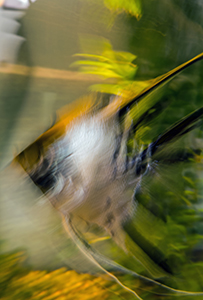
by Carl Crumley
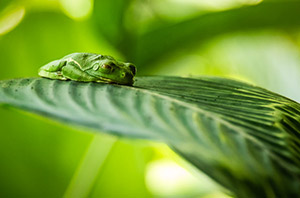
Sleepy
by Joann Long
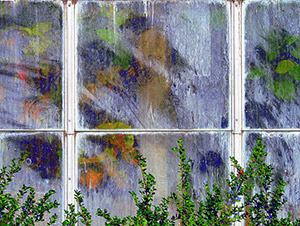
Dirty Windows
by David
Schroeder
David’s forte lately has been for
minimalization and strong abstracts that highlight texture, color, lines
or whatever he wishes to emphasize as he peers through his lens.
David challenges the viewer to view something specific rather than
stepping back to see the full scene. Dirty Window is a
symmetrical design of six windowpanes, though no one pane is complete in
the frame. Each pane is dirty, but not as in brownish or brackish color
that obscures the view. Rather, it appears as if someone has taken a
brush and finely brushed or swirled a substance on the glass. This
whitish color may have been from a long ago paint decomposition that has
streaked the window. Upon closer examination, as one looks through the
windows there are splashes of color like someone used a large strokes of
different colors on a tapestry. What emerges are blurred colors that
seem to represent plants. What is clear is that David places these
colors in the left side of the frame near the power positions thus
creating a tension with the symmetrical feel of the windowpanes. As with
a landscape image the sharp focus foreground of green plants with
touches of red serve as a counterpoint to the swath of color hiding just
inside the middle ground window that has a pleasing texture. All of this
adds the perception of depth to the photo that may not have been
apparent at first glance.
David searches for patterns and
textures where others may over look or not deem important from a broader
perspective. Ironically, he challenges us to see a broader perspective
within a very tight frame. Dirty Windows is a very pleasing
work of art.
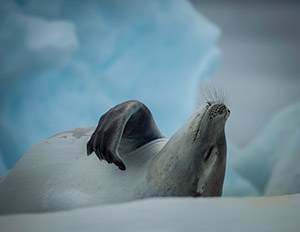
Whiskers
by Michelle Turner
Image City Photography Gallery ♦ 722 University Avenue ♦ Rochester, NY 14607 ♦ 585.271.2540
In the heart of ARTWalk in the Neighborhood of the Arts